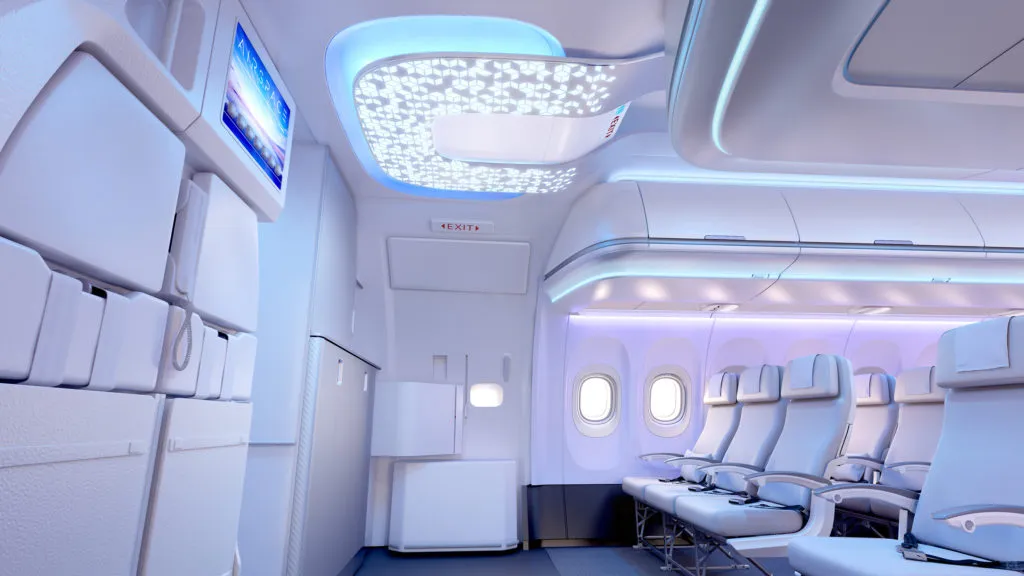Supply chain problems with engines are still causing headaches for raising the rate of production of the Airbus A320neo family, but the passenger experience cabin interiors supply chain comes closely behind as the company looks to exceed the planned 63-per-month aircraft rate intended for 2021, Airbus executives tell Runway Girl Network at the company’s Innovation Days outside Toulouse.
The supply chain, says executive vice president for programmes and services Philippe Mhun, “put us in kind of a corner”, but the airframer is “working on it”. On the engines side, Airbus is seeking both reliability of production and a secured, reliable supply of certain key raw materials. “We are having some discussions with both engine manufacturers, and having a look at what could be feasible in years to come,” Mhun tells RGN on the subject of raising the rate.
Airbus is still playing coy with the multiple A321neo stretches of range and fuselage that have been mooted: the “A322” fuselage stretch of the A321neo, the “A321XLR” that extends the range of the Long-Range version of the family, and an “A322LR/XLR” option set that combines both.
Reading between the lines at an event where Airbus executives are very careful not to tempt fate in criticizing Boeing, the 737 MAX problems mean the US airframer’s turn to move in the middle of the market might be delayed, especially the longer the MAX remains grounded.
This delay would give Airbus some breathing room to firm up its supply chain to prepare for the event that it wants to raise A320neo family production. Given the number of airlines converting smaller 737 MAXes to the double-stretched MAX 10, and indeed converting up to A321neo and A321LRs from the A320neo family, it would be reasonable to expect Airbus to be as keen as Boeing to sell longer, more expensive aircraft in the family that take up the same space in production queues as shorter, less expensive A320neos (or indeed A319neos).
Yet there are commercial considerations too, Scherer tells RGN. “Commercially, we want to be a little bit careful as well that we’re not doing this to flood the market. We have a lot of customers who are now engaged on this asset [the A320neo aircraft family], and we don’t want to destroy asset values or encourage too much competitive asset value dilution.”
“I am,” Scherer says, referring to the fact that he as sales supremo can’t sell more aircraft given the backlog, “in the fortunate situation to be constrained, so we keep the value of our products up quite nicely.”
But crucially, Scherer says, “the supply chain are partners, de facto, in our journey. Whenever we are looking at longer-term trends for production rate and so on, we are sharing our view with the supply chain, and depending on the commodity we are talking about the challenges of a different nature. Having a holistic view of the aerostructure, the industry is still consolidating, and these are things that could result in a higher investment capacity.”
Suppliers do, however, “still need to improve their industrial capabilities to be a more predictable partner,” Scherer says.
This message on higher investment capacity from larger conglomerates appears from Mhun during a later discussion with RGN too. “This is why we welcome the fact that, B/E being bought by Rockwell, now part of Collins, you have experts of industrialization in Collins’ world,” Mhun says.
“Safran buying Zodiac was good news for us because they bring also their industrial expertise to the product. At the end of the day this is what we are looking for. I think they are on the right path; nevertheless, the rampup is huge for them too, not only in terms of the number of aircraft times the number of seats, and we can appreciate it is an industrial challenge.”
Related Articles:
- MAX pain could see some suppliers gain, but nobody is celebrating
- Amid delays, aircraft interior suppliers focus internally
- Air Lease Corp “very disturbed” with Airbus and P&W as delays bite
- Growing pains of Pratt-powered A320neo presents challenges for airlines
- Despite problems, A350 and A320neo point to improving launches
- Interiors delays continue to stress Airbus delivery schedule
- B/E Aerospace expects to benefit from Zodiac’s seat delay woes
- Zodiac seat delays underscore broader constraint in supply chain
- Airbus logistics provider innovates to support complex supply chain













